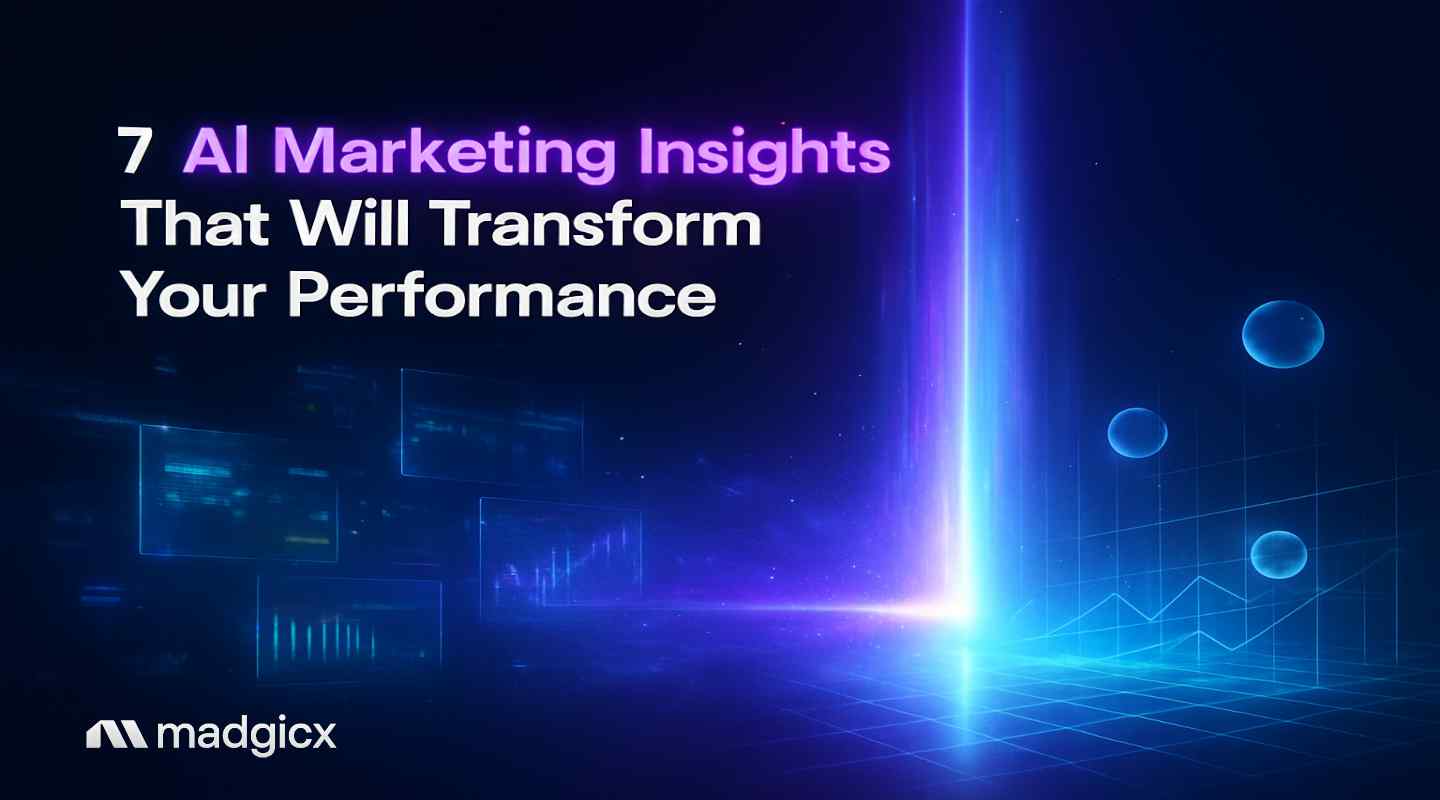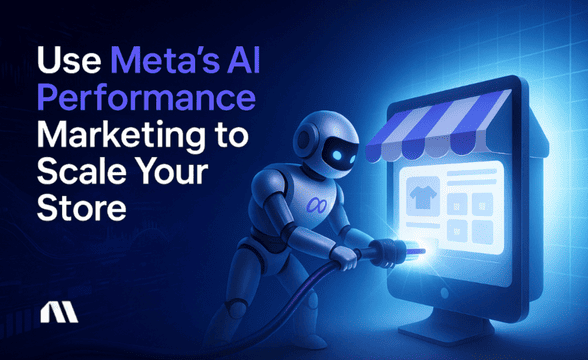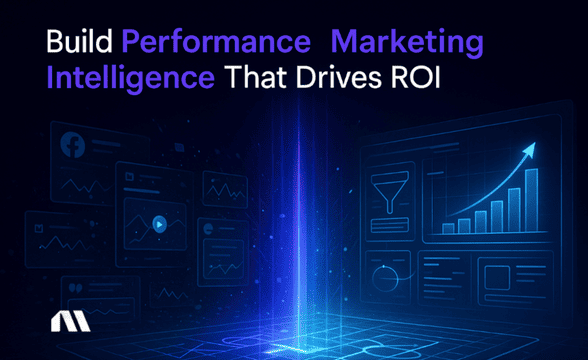Discover 7 AI marketing insights transforming performance. Learn real-time optimization, predictive modeling, and automated strategies driving ROI improvements.
Picture this: You're reviewing your campaign performance on Monday morning, coffee in hand, when you notice something unsettling. Your biggest competitor's ads are suddenly crushing yours – their CTR is up 180%, their CPA dropped by 40%, and they're scaling budgets like there's no tomorrow.
What changed? They didn't hire a superstar team or launch a revolutionary product. They simply embraced AI optimization while you were still manually adjusting bids at 2 AM.
Here's the reality check we all need: AI marketing insights aren't coming to performance marketing – they're already here, and they're reshaping everything. According to Nielsen's 2025 Marketing Report, 59% of global marketers now prioritize AI personalization as their top trend.
The question isn't whether you should adopt AI marketing insights; it's whether you can afford to fall behind while your competitors automate their way to better performance.
We're about to dive into 7 game-changing AI marketing insights that separate the performance marketers who are thriving in 2025 from those who are still stuck in manual optimization mode. These aren't theoretical concepts – they're practical strategies that are driving real results right now.
What You'll Learn
Ready to transform your approach to performance marketing? Here's exactly what we're covering:
- How 92% of top-performing businesses leverage AI personalization for campaign optimization
- The 7 AI marketing insights driving ROI improvements in 2025
- Specific implementation strategies for each AI trend in your current campaigns
- Bonus: ROI measurement frameworks to prove AI marketing success to stakeholders
Let's get into the insights that are reshaping performance marketing as we know it.
The AI Marketing Revolution: Where We Stand in 2025
Remember when "AI marketing" felt like science fiction? Those days are long gone. We're now living in an era where artificial intelligence processes campaign data faster than any human team could dream of, and the results speak for themselves.
AI marketing insights are data-driven discoveries about consumer behavior, campaign performance, and optimization opportunities generated through artificial intelligence analysis. Think of them as your crystal ball for understanding what works, what doesn't, and what's coming next – all backed by machine learning algorithms that never sleep.
The adoption rate is staggering. Nielsen's research shows that 80% of companies have significantly adopted AI in their measurement efforts. This isn't a trend anymore; it's the new standard for competitive performance marketing.
But here's what most marketers miss: AI marketing insights aren't just about automating what you're already doing. They're about discovering insights and optimization opportunities that humans simply can't spot in the noise of campaign data. The performance marketers who understand this distinction are the ones pulling ahead in 2025.
AI Marketing Insight #1: Real-Time Campaign Optimization Beats Manual Adjustments
Let's be honest – how often do you check your campaigns? Twice a day? Every few hours? Even the most dedicated performance marketers can't monitor campaigns 24/7, but AI can. And that constant vigilance is where the magic happens.
Real-time optimization means your campaigns are being monitored continuously with AI-powered recommendations for adjustments based on performance data, not every few hours when you remember to log into Ads Manager. We're talking about recommended bid adjustments, budget reallocations, and audience refinements happening while you sleep.
Madgicx's AI Marketer exemplifies this perfectly. It performs daily Meta ad account audits automatically and provides actionable optimization recommendations with one-click implementation. Instead of spending your morning coffee break hunting for underperforming ad sets, you're getting expert-level insights delivered to your dashboard.
You can try Madgicx’s AI for free.
Pro Tip: Start by setting up automated rules for your biggest pain points. If you're constantly pausing ads with high CPAs, create an automation rule that does this for you when performance drops below your threshold. It's like having a performance marketing assistant who never takes a break.
The difference between manual and AI optimization isn't just efficiency – it's effectiveness. AI can spot patterns in your data that would take humans weeks to identify, then recommend actions on those insights immediately.
AI Marketing Insight #2: Predictive Audience Modeling Outperforms Traditional Targeting
Traditional audience targeting feels like throwing darts in the dark compared to what AI can do now. Instead of guessing which demographics might convert, AI analyzes behavioral patterns to predict which users are most likely to take action before they even see your ads.
This is where the numbers get really interesting. According to Taboola and McKinsey's 2025 research, 92% of businesses now use AI-driven personalization for campaign optimization. They're not just targeting broad demographics anymore – they're targeting behavioral intent.
Predictive audience modeling works by analyzing thousands of data points about user behavior, purchase history, and engagement patterns. The AI identifies subtle signals that indicate purchase intent, then builds audiences around those signals rather than basic demographics.
Pro Tip: If you're still relying solely on Facebook's standard lookalike audiences, you're missing out. AI-powered audience modeling can identify micro-segments within your existing customers that perform significantly better than broad lookalikes.
The beauty of predictive modeling is that it gets smarter over time. Every conversion, every click, every interaction feeds back into the algorithm, making future predictions more accurate. It's like having a targeting specialist who learns from every campaign you run.
AI Marketing Insight #3: Creative Performance Prediction Reduces Testing Costs
Creative testing used to be expensive guesswork. You'd launch multiple variations, spend budget on each, wait for statistical significance, then pick a winner. AI flips this process on its head by predicting creative performance before you spend a dime.
Modern AI can analyze visual elements, copy patterns, and historical performance data to forecast which creatives are most likely to succeed with your target audience. This means you can prioritize your highest-potential creatives from day one instead of spreading budget equally across all variations.
Madgicx's AI Ad Generator takes this concept further by creating high-quality, thumb-stopping Meta image ads through AI, then using its AI editor to optimize generated images based on performance predictions. You're not just testing random creative variations – you're testing AI-optimized variations designed for your specific audience.
Implementation Strategy: Before launching your next creative test, run your variations through AI analysis to rank them by predicted performance. Start with 70% of your budget on the top-predicted performers and 30% on the others. This approach typically reduces testing costs by 40-60% while maintaining statistical validity.
The real game-changer here is speed. Instead of waiting weeks to identify winning creatives, AI can give you performance predictions within hours of launch. This acceleration means you can iterate faster and scale winners sooner.
AI Marketing Insight #4: Multi-Touch Attribution Addresses the iOS Challenge
iOS privacy changes hit performance marketers like a freight train, but AI attribution models are helping address the tracking challenges we've all been facing. Traditional last-click attribution was already flawed, but iOS made it nearly useless for understanding true campaign performance.
Multi-touch attribution AI helps solve this by analyzing all touchpoints in the customer journey, not just the last click before conversion. It uses machine learning to assign appropriate credit to each interaction, giving you a more complete picture of what's actually driving results.
The technical solution happens through server-side tracking and first-party data collection. Madgicx's Cloud Tracking, for example, implements server-side first-party tracking that addresses iOS17 data collection challenges specifically. This means improved data flowing back to Facebook for optimization, which translates to better campaign performance.
iOS Solution Framework:
- Implement server-side tracking for improved data collection
- Use AI attribution models to understand true campaign impact
- Optimize based on multi-touch insights rather than last-click data
- Set up first-party data collection to reduce platform dependency
The performance difference is significant. Advertisers using AI-powered attribution typically see improvements in campaign optimization because they're making decisions based on more complete data rather than fragmented insights.
AI Marketing Insight #5: Automated Budget Allocation Maximizes Campaign ROI
Manual budget management is where most performance marketers lose money without realizing it. You set budgets based on historical performance, but AI can recommend budget redistributions in real-time based on current performance trends and predictive modeling.
Here's where the ROI impact gets serious. Industry research shows that marketing automation can deliver significant ROI improvements when implemented strategically. The key is moving beyond basic automation to intelligent budget recommendations that respond to performance signals immediately.
AI budget allocation works by continuously analyzing performance across all your campaigns and recommending budget shifts toward the highest-performing opportunities. If Campaign A is delivering a 3x ROAS while Campaign B is struggling at 1.5x, AI will recommend gradually moving budget from B to A with minimal manual oversight required.
Budget Optimization Strategy:
- Set performance thresholds for automatic budget increases (e.g., ROAS > 4x)
- Create rules for budget decreases when performance drops (e.g., ROAS < 2x for 24 hours)
- Allow AI to recommend redistributing 20-30% of your total budget based on real-time performance
- Monitor weekly to ensure allocation aligns with your strategic priorities
The compound effect of optimized budget allocation is massive. Instead of having budget trapped in underperforming campaigns for days or weeks, you're constantly feeding your winners and starving your losers. This dynamic approach typically improves overall account ROAS by 25-40%.
AI Marketing Insight #6: Performance Prediction Enables Proactive Strategy Adjustments
Reactive marketing is expensive marketing. By the time you notice a campaign declining, you've already wasted budget. Performance prediction AI changes this by forecasting performance trends before they impact your results.
AI analyzes patterns in your campaign data to predict when performance is likely to decline, when audiences might become saturated, and when seasonal trends will affect your results. This early warning system lets you adjust strategy proactively instead of reactively.
Think of it as having a performance marketing crystal ball. Instead of discovering that your winning campaign hit audience fatigue after spending $5,000 on declining performance, AI alerts you when fatigue patterns start emerging so you can refresh creative or expand targeting before performance drops.
Proactive Optimization Framework:
- Set up performance prediction alerts for key campaigns
- Create contingency plans for predicted performance declines
- Prepare creative refreshes before audience fatigue hits
- Scale successful campaigns before they plateau
The strategic advantage is enormous. While your competitors are reacting to performance changes, you're anticipating them. This proactive approach typically reduces wasted spend by 30-50% and extends the profitable lifespan of successful campaigns.
AI Marketing Insight #7: Integrated AI Workflows Eliminate Platform Switching
Platform switching is the silent killer of performance marketing productivity. You're jumping between Ads Manager, analytics tools, creative platforms, and reporting dashboards all day. AI integration eliminates this chaos by bringing everything into unified workflows.
Modern AI platforms don't just optimize individual functions – they connect the entire performance marketing ecosystem. Creative generation informs audience targeting, which influences budget allocation, which feeds back into creative optimization. Everything works together instead of in isolation.
Madgicx exemplifies this integration by combining AI-powered creative generation with campaign optimization and performance analytics AI in one platform. Instead of using separate tools for creative, optimization, and reporting, you're managing everything through integrated AI workflows that share data and insights across functions.
Integration Benefits:
- Faster decision-making with all data in one place
- Better optimization through cross-platform insights
- Reduced human error from manual data transfer
- More time for strategy instead of platform management
The productivity gains are substantial, but the real value is in the quality of insights. When your creative tool talks to your optimization tool, which talks to your analytics tool, you get a complete picture of performance that's impossible to achieve with disconnected platforms.
Frequently Asked Questions About AI Marketing Insights
How can small performance marketing teams leverage AI without huge budgets?
Start with one AI tool that addresses your biggest pain point. If you're spending too much time on manual optimizations, begin with automated campaign management. If creative testing is eating your budget, start with AI creative prediction. Most AI platforms offer tiered pricing that scales with your spend, making them accessible even for smaller teams.
What's the realistic ROI timeline for implementing AI marketing insights?
You'll typically see initial improvements within 2-4 weeks as AI learns your account patterns. Significant ROI improvements usually emerge after 6-8 weeks when the algorithms have enough data to make confident optimizations. The key is consistent implementation rather than expecting overnight transformations.
How do I measure the actual impact of AI on my campaign performance?
Set up before-and-after comparisons using the same time periods, audience sizes, and budget levels. Track metrics like cost per acquisition, return on ad spend, and time spent on manual optimizations. Most AI platforms also provide attribution reports showing specific optimizations and their performance impact.
Which AI marketing insights should I prioritize first for maximum impact?
Focus on real-time optimization first – it provides immediate value and frees up your time for strategic work. Next, implement predictive audience modeling to improve targeting efficiency. Save advanced attribution and budget allocation for later phases when you have solid foundations in place.
How do AI marketing insights work with privacy regulations and iOS changes?
AI actually helps with privacy compliance by reducing dependence on third-party tracking. Server-side tracking and first-party data collection (core components of AI attribution) are more privacy-friendly and iOS-resistant than traditional tracking methods. AI helps you maintain performance while respecting user privacy preferences.
Transform Your Performance Marketing with AI Marketing Insights
The seven AI marketing insights we've covered aren't just trends – they're the new fundamentals of competitive performance marketing in 2025. Real-time optimization, predictive audience modeling, creative performance prediction, multi-touch attribution, automated budget allocation, performance prediction, and integrated workflows are reshaping how successful marketers operate.
The data backs this up. Research shows that businesses implementing AI marketing strategies see 20–30% higher ROI improvements on average. But here's the crucial point: these improvements compound over time as AI systems learn and optimize.
Early adopters aren't just getting better results – they're building competitive moats that become harder to overcome as their AI systems accumulate more data and insights. The performance marketers who embrace these AI marketing insights now will be the ones dominating their markets in 2026 and beyond.
Your next step is simple: audit your current campaigns for AI optimization opportunities. Look at where you're spending the most time on manual tasks, where you're making decisions based on incomplete data, and where you're reacting to performance changes instead of predicting them.
Madgicx combines all seven of these AI marketing insights in one comprehensive platform, helping thousands of performance marketers automate optimization, predict performance, and scale profitably. The question isn't whether AI will transform your performance marketing – it's whether you'll lead that transformation or follow it.
The future of performance marketing is AI-powered, data-driven, and automated. The marketers who understand this today will be the ones winning tomorrow.
Reduce manual Meta ad optimization time with AI-powered recommendations. Madgicx's AI Marketer monitors your performance data 24/7 and provides actionable optimization recommendations to help maximize your ROI while you focus on strategy.
Digital copywriter with a passion for sculpting words that resonate in a digital age.







.avif)







